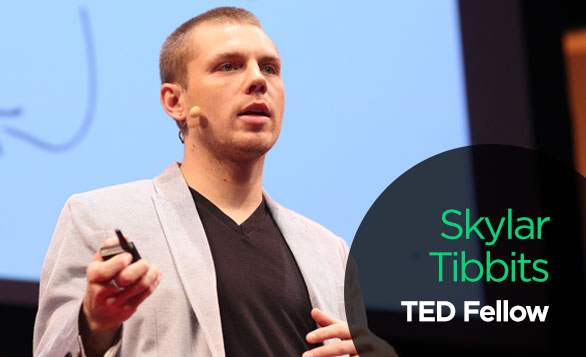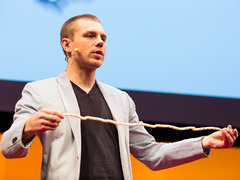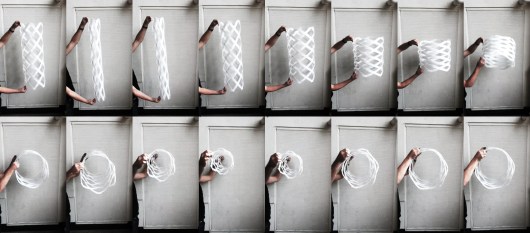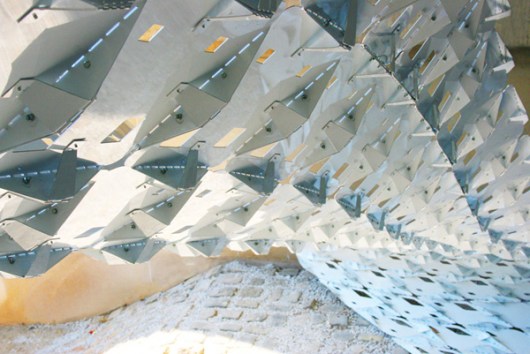
Skylar Tibbits makes things that assemble themselves, with potential large-scale applications from self-adjusting water pipes to self-assembling structures in space. At his recently founded Self-Assembly Lab at MIT, he’s pioneering 4D printing — using smart materials to make objects that change shape and evolve. Here, he explains how 4D printing works, and describes his journey from architect to artist to leading inventor of self-assembly technology.
Why is this process called 4D printing?
The reason we call it 4D is because the object changes over time. So whereas 3D printing simply creates an object,
 Skylar Tibbits: The emergence of "4D printing"
the 4D-printed object is printed using smart materials that are activated by various sources — like heat, water, current, sound, pressure, and so on.
Skylar Tibbits: The emergence of "4D printing"
the 4D-printed object is printed using smart materials that are activated by various sources — like heat, water, current, sound, pressure, and so on.
Objects are printed with the multi-material printer using a combination of smart material and standard 3D printing material — currently, Stratasys’ Connex highly precise multi-material 3D printers can print two materials — in whatever shape you want. Then when you activate the object, it changes: swells or contracts or moves.
Right now the material we’re using is a polymer-based water-absorbing material that expands 150%. For the non-4D material, Stratasys has a whole line, everything from soft rubber to plastic. Right now we use their hard black plastic, just a standard plastic material, alongside the 4D material as the activator.
So the expanding material does one thing and the rigid material holds the shape, is that right?
Right. The rigid material gives it structure and constraints. If you have two pieces and you want them to fold, how do you make it go the right direction? That way or another way? Well, you put a very thin piece of rigid material on the side you want to fold. So that means that the expanding material is going to expand, and that super thin material is going to bend. And so this basically creates a force. But then the question is, how do you make it so that the bend stops at the correct angle? So you add rigid limiters. You also use the lengths of the segments to achieve the shape you want. The rigid material is the code, and the expanding material is the energy.
It’s just become a really elegant process from start to finish, where my hands are out of it the whole time. I build intent, but the object is manufactured as a streamlined piece. You dip it in water and it goes by itself.
Video above: A demonstration of 4D Printing, the “MIT” self-folding strand in action.
The first time you saw the test object fold by itself in water, were you incredibly excited?
I had one surprising moment. I set it in water, and I had my camera set up doing a time-lapse — the process is so slow you can’t see it moving in real time. A few hours later I came back and it was folded. And I thought, “Oh, cool. It folded. It works.” But then I looked at the time-lapse and went, “Whoa!” — because it looks like a live worm. It’s not just click, click — MIT. It takes weird dynamic forms to get there. So that was cool.
How did you originally connect with Stratasys?
It’s actually a funny story. I was at a coffee shop, in Cambridge, right across from MIT, and the person across from me had a shirt on that said Objet — the 3D printing company that later merged with and became Stratasys. We started talking, and I introduced her to the department of architecture at MIT. I showed her the work I’m doing, saying, “I wish there was a way we could print this stuff so that we could embed the energy directly into it.” She connected me with their materials science division, which was developing this material that expands in water. Together we realized this wasn’t just a weird material that we don’t know what to do with, but a new paradigm for what you can print.
You are the only person working on designs for this material and this particular process. So do you get all the credit for 4D?
Well, Stratasys developed the materials and the machine, so this wouldn’t be possible without them. I had the vision of how this would be a real change in the game of 3D printing. This only became a reality once we produced the prototypes and demonstrated that it is possible. But I think 4D printing is something that in the future anyone can do. If the materials were on the market, everyone would be 4D printing tomorrow.
But you need the design knowledge.
That’s true. There’s the whole democratizing-design world, and they’re trying to make it so anyone can 3D print anything. This falls into that realm. It’s a little bit more complex because you need to be smart enough to figure out, say, if you want to make a fairly complex and intricate shape, you need to then be able to figure out what’s the pattern for it to go from here to here — and that’s not always easy. Going from a line to a circle is pretty straightforward. You can make a strip, and you can make a standard interval, and it will curl uniformly. But if you want to make something more intricate, you need to have the tools to be able to do that. So we started to collaborate with Autodesk to help develop new design tools for this — tools that allow you design around self-assembly principles as well as simulate and optimize the folding patterns.
Video above: A demonstration of a self-folding sheet, created at the MIT Self-Assembly Lab.
So what now? Are you thinking up ways to apply this technology to designs?
Yes. So far we’ve demonstrated that a one-dimensional form folds into a three-dimensional form. One goal is to go as complex as possible. I’m trying to do a 50-foot long strand that folds into eight inches: it’s called the Hilbert curve — a mathematical curve. So that would demonstrate that we can do highly simple first parts that lead to very complex other structures. And it also may have implications for studying protein folding, how they can go from one configuration to another, how they don’t tangle, and what design parameters are essential. But I also want to demonstrate all of the other low-hanging fruit — a flat 2D sheet that folds into a rigid 3D structure. A 3D object like a cube that turns into a sphere. We know we can do it — we just haven’t. There are a ton of these.
After we’ve proved we can build complex things and we can do all geometric transformations, then we can start to use the technology for more real-world applications. Then we will need to push the materials further and make sure we have the right properties so that it is scalable. Part of me is just fascinated by pushing the boundaries of what we know, what’s possible, what materials can do, and how much information you can embed. But I also want to make large-scale things and solve real-world problems with them.
You’ve talked to us about applying self-assembly technology to adaptable infrastructure like piping and bridges, low-energy manufacturing, and passive energy construction techniques. What about potential applications for space?
We have been working with Shackleton Energy as a design advisor to help build space infrastructure systems using these principles. They are looking to build a whole pipeline space infrastructure for fueling and energy extraction. The idea is to provide an infrastructure for all of the private space companies, so that they don’t have to keep going back and forth, but stay in space longer. So they need an energy supply chain, module components and smart ways they can connect to one another.
The opposite paradigm is the International Space Station: it comprises extremely complex and expensive technology made all around the world, coming together in complex ways. Nearly no module is the same. In contrast, we want to develop simple systems that can be shipped, then expand in orbit and are reconfigurable. These would be standard components that come together in many, many ways, so you have massive design possibility with a minimum number of components.

Adaptable infrastructure: pipes that expand and contract according to need. Photo: MIT Self-Assembly Lab
Why is 4D — and self-assembly — necessary?
The short answer is that I don’t like manual labor. People always comment that my work reduces energy consumption. But I never say that; I say it uses alternative energy sources like heat, shaking, and so on. The extra energy required to make smarter parts that self-assemble could be offset by reducing the expensive and huge amount of energy used in construction.
Well, 4D radically modifies that argument, because the manufacturing side would also be streamlined. There isn’t excessive labor to make the parts “smart”: I don’t have to embed magnets in every single piece, for example. It goes right from design to reality — and it doesn’t stop at reality. Smart materials can even continue to adapt — changing shape or texture. But the manufacturing process is streamlined.
How did you become interested in self-assembly in the first place?
 Skylar Tibbits: Can we make things that make themselves?
It all began in 2007, when I was in architecture school, as an undergrad in Philly. I was building these huge sculptures and breaking my back.
Skylar Tibbits: Can we make things that make themselves?
It all began in 2007, when I was in architecture school, as an undergrad in Philly. I was building these huge sculptures and breaking my back.
Were you originally an artist?
When I was a kid, I wanted to be an artist. I was always drawing, and also making stuff. And I was into photography in middle school and high school. But somehow I thought architecture was a lucrative art form. Architecture was all software-based, but at a certain point, you get to the limits of software. I started learning how to write code. And the code is what led to the sculptures.
Generative art was a brand-new field at the time. At the same time, digital fabrication began. It was all brand new: fab labs were popping up, architecture schools were getting robotic fabrication machines, and laser cutters and 3D printers. Suddenly there was this code explosion, which meant that people like me could make stuff that no one else could make. It was the students that were pumped about this new technology. “Wow, we have all these crazy design tools and digital fabrication tools. Now we can build stuff that hadn’t been possible before — and with one percent of the budget.”
What was your big break?
I got a huge opportunity to do an exhibition in Philly in 2007, at the Real World house in this old bank. It’s two floors, balcony. They offered me the whole space. I pitched to do something called “Scripted by Purpose,” which was a collaboration with TED Fellow Marc Fornes. The idea was using scripted processes for design. And so we brought anyone from around the world that we knew that was doing generative design at the time.
We had architects, but we also had Vito Acconci there, Marius Watz and Francois Roche, and other well-known architects, artists and designers. We were the first ones in the design world to put together such an exhibition, so people started inviting us to do exhibitions around the world. For us, it was an opportunity to make stuff in ways that people weren’t making before. And we could compete. Big architects were doing wild projects with billions of dollars. We could do wild geometries in smarter ways, because we could write code and run machines ourselves — for little money. But it was manual labor — people fabricating, assembling, connecting things, finishing the parts. Eventually the labor side of it made me realize that there had to be a better way. Not just code to design stuff, not just code to make stuff, but code to assemble stuff as well.
Somewhere in there, I joined MIT Design Computation Group and started working on programmable matter and robotics, artificial intelligence, and eventually the biology stuff crept in. That showed me possibilities of construction at other length-scales that used computational processes and embedded assembly information. That led to the research on self-assembly!
So you did ultimately get to be an artist.
Yes, I am an artist, but I also think of myself as an architect. My art was always trying to prove an architectural point. My first installation was called “Flat Panel Quadrilateral Tessellations.” It basically said that we can make complex, doubly curved surfaces, out of flat pieces of material. So it’s super cheap and super easy to build, all through code and coded machines.
For me, the most exciting challenge is not to do the same thing ever again, or to keep critiquing myself each time: how could it be smarter, how could this thing be more streamlined or do things that we didn’t expect? Each time I start something new, I want to do something I couldn’t have imagined was possible.
How has the TED Fellowship had an impact on your life and work so far?
The TED Fellowship has given me the opportunity, network and confidence to start my own lab at MIT, the Self-Assembly Lab. I likely wouldn’t have been able to take that trajectory otherwise. TED has also really been a research testbed and an opportunity to experiment. I’ve been fortunate enough to exhibit work during three of the four conferences that I’ve attended — putting the work out there, getting feedback, getting exposure and using it as a stage for development. I think this has really been a unique experience, much more tangible and direct than I could have imagined.
Video above: Watch Tibbits’ recently posted TED-Ed animation: “Self-assembly: The power of organizing the unorganized.”

Comments (9)
Pingback: Introduction to 4D Printing. - Ware Bros. Inc.
Pingback: A very cool new video: A brief introduction to 4D printing
Pingback: A very cool new video: A brief introduction to 4D printing | Best Science News
Pingback: A very cool new video: A brief introduction to 4D printing | BizBox B2B Social Site
Pingback: A very cool new video: A brief introduction to 4D printing | H Tanalepy
Pingback: A very cool new video: A brief introduction to 4D printing - nuhrdspace.com
Pingback: Retro shooter ‘Far Cry 3: Blood Dragon’ gets an amazing Saturday morning cartoon treatment | Toki Solutions